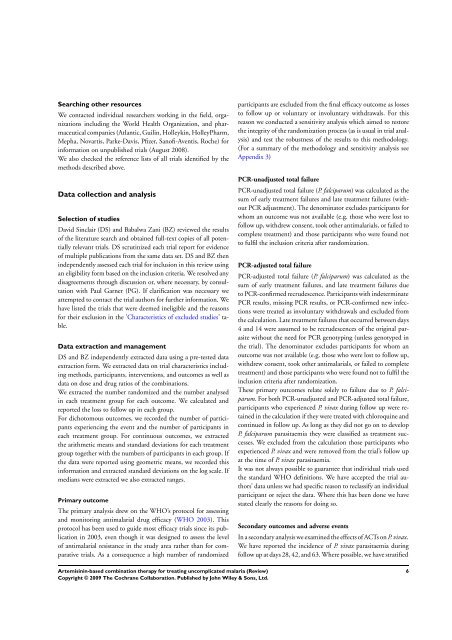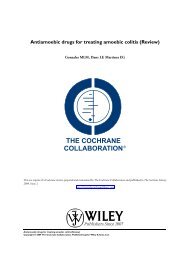Artemisinin-based combination therapy for ... - The Cochrane Library
Artemisinin-based combination therapy for ... - The Cochrane Library
Artemisinin-based combination therapy for ... - The Cochrane Library
Create successful ePaper yourself
Turn your PDF publications into a flip-book with our unique Google optimized e-Paper software.
Searching other resources<br />
We contacted individual researchers working in the field, organizations<br />
including the World Health Organization, and pharmaceutical<br />
companies (Atlantic, Guilin, Holleykin, HolleyPharm,<br />
Mepha, Novartis, Parke-Davis, Pfizer, Sanofi-Aventis, Roche) <strong>for</strong><br />
in<strong>for</strong>mation on unpublished trials (August 2008).<br />
We also checked the reference lists of all trials identified by the<br />
methods described above.<br />
Data collection and analysis<br />
Selection of studies<br />
David Sinclair (DS) and Babalwa Zani (BZ) reviewed the results<br />
of the literature search and obtained full-text copies of all potentially<br />
relevant trials. DS scrutinized each trial report <strong>for</strong> evidence<br />
of multiple publications from the same data set. DS and BZ then<br />
independently assessed each trial <strong>for</strong> inclusion in this review using<br />
an eligibility <strong>for</strong>m <strong>based</strong> on the inclusion criteria. We resolved any<br />
disagreements through discussion or, where necessary, by consultation<br />
with Paul Garner (PG). If clarification was necessary we<br />
attempted to contact the trial authors <strong>for</strong> further in<strong>for</strong>mation. We<br />
have listed the trials that were deemed ineligible and the reasons<br />
<strong>for</strong> their exclusion in the ’Characteristics of excluded studies’ table.<br />
Data extraction and management<br />
DS and BZ independently extracted data using a pre-tested data<br />
extraction <strong>for</strong>m. We extracted data on trial characteristics including<br />
methods, participants, interventions, and outcomes as well as<br />
data on dose and drug ratios of the <strong>combination</strong>s.<br />
We extracted the number randomized and the number analysed<br />
in each treatment group <strong>for</strong> each outcome. We calculated and<br />
reported the loss to follow up in each group.<br />
For dichotomous outcomes, we recorded the number of participants<br />
experiencing the event and the number of participants in<br />
each treatment group. For continuous outcomes, we extracted<br />
the arithmetic means and standard deviations <strong>for</strong> each treatment<br />
group together with the numbers of participants in each group. If<br />
the data were reported using geometric means, we recorded this<br />
in<strong>for</strong>mation and extracted standard deviations on the log scale. If<br />
medians were extracted we also extracted ranges.<br />
Primary outcome<br />
<strong>The</strong> primary analysis drew on the WHO’s protocol <strong>for</strong> assessing<br />
and monitoring antimalarial drug efficacy (WHO 2003). This<br />
protocol has been used to guide most efficacy trials since its publication<br />
in 2003, even though it was designed to assess the level<br />
of antimalarial resistance in the study area rather than <strong>for</strong> comparative<br />
trials. As a consequence a high number of randomized<br />
<strong>Artemisinin</strong>-<strong>based</strong> <strong>combination</strong> <strong>therapy</strong> <strong>for</strong> treating uncomplicated malaria (Review)<br />
Copyright © 2009 <strong>The</strong> <strong>Cochrane</strong> Collaboration. Published by John Wiley & Sons, Ltd.<br />
participants are excluded from the final efficacy outcome as losses<br />
to follow up or voluntary or involuntary withdrawals. For this<br />
reason we conducted a sensitivity analysis which aimed to restore<br />
the integrity of the randomization process (as is usual in trial analysis)<br />
and test the robustness of the results to this methodology.<br />
(For a summary of the methodology and sensitivity analysis see<br />
Appendix 3)<br />
PCR-unadjusted total failure<br />
PCR-unadjusted total failure (P. falciparum) was calculated as the<br />
sum of early treatment failures and late treatment failures (without<br />
PCR adjustment). <strong>The</strong> denominator excludes participants <strong>for</strong><br />
whom an outcome was not available (e.g. those who were lost to<br />
follow up, withdrew consent, took other antimalarials, or failed to<br />
complete treatment) and those participants who were found not<br />
to fulfil the inclusion criteria after randomization.<br />
PCR-adjusted total failure<br />
PCR-adjusted total failure (P. falciparum) was calculated as the<br />
sum of early treatment failures, and late treatment failures due<br />
to PCR-confirmed recrudescence. Participants with indeterminate<br />
PCR results, missing PCR results, or PCR-confirmed new infections<br />
were treated as involuntary withdrawals and excluded from<br />
the calculation. Late treatment failures that occurred between days<br />
4 and 14 were assumed to be recrudescences of the original parasite<br />
without the need <strong>for</strong> PCR genotyping (unless genotyped in<br />
the trial). <strong>The</strong> denominator excludes participants <strong>for</strong> whom an<br />
outcome was not available (e.g. those who were lost to follow up,<br />
withdrew consent, took other antimalarials, or failed to complete<br />
treatment) and those participants who were found not to fulfil the<br />
inclusion criteria after randomization.<br />
<strong>The</strong>se primary outcomes relate solely to failure due to P. falciparum.<br />
For both PCR-unadjusted and PCR-adjusted total failure,<br />
participants who experienced P. vivax during follow up were retained<br />
in the calculation if they were treated with chloroquine and<br />
continued in follow up. As long as they did not go on to develop<br />
P. falciparum parasitaemia they were classified as treatment successes.<br />
We excluded from the calculation those participants who<br />
experienced P. vivax and were removed from the trial’s follow up<br />
at the time of P. vivax parasitaemia.<br />
It was not always possible to guarantee that individual trials used<br />
the standard WHO definitions. We have accepted the trial authors’<br />
data unless we had specific reason to reclassify an individual<br />
participant or reject the data. Where this has been done we have<br />
stated clearly the reasons <strong>for</strong> doing so.<br />
Secondary outcomes and adverse events<br />
In a secondary analysis we examined the effects of ACTs on P. vivax.<br />
We have reported the incidence of P. vivax parasitaemia during<br />
follow up at days 28, 42, and 63. Where possible, we have stratified<br />
6








